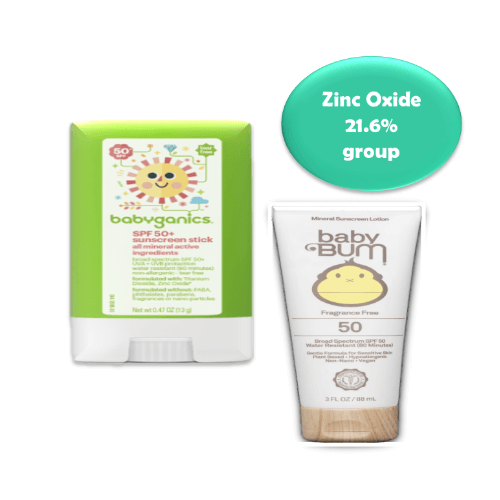After spending hours analysing dozens of kid’s sunscreens in CVS pharmacies around NYC, I have a list of only three, that my imaginary child is being slathered in. I am disappointed with this outcome and I will keep looking.
I have written a brief guide “Infants and kids: a short guide to sunscreen” which I’d encourage you to read. To reiterate a few key points:
i) Why is sun protection for kids so critical?
The main reason is that data shows “regular use of sunscreen” reduces the risk of skin cancer. Skin cancer is more prevalent then you imagine. One in 5 Americans will get skin cancer – that’s the American Academy of Dermatology – AND 80% of skin cancers are due to sun exposure under the age of 18.
How is that possible? Well, sun damage is CUMULATIVE and this chart shows the Average Accumulated Sun Exposure based on a 78 year life expectancy.
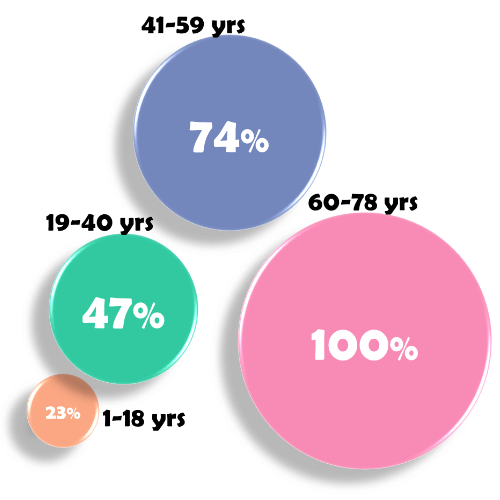
i) Sunscreen does not make your kid’s skin immune to sun damage
My favourite negative review is how a Banana Boat kid product did not prevent a 2 year old who spent the entire day on a sunny beach from getting sunburnt.
I laughed the first time I read it, but not so much when I kept reading similar comments for other products.
Here is the thing: sunscreen is not a miracle product that makes human skin immune from sunburn. If Banana Boat did succeed in making a bulletproof, 100% UVA and UVB blocker, it would patent the technology and then sell it to everyone for a gazillion dollars and not US$ 9.99.
iii) Active Ingredients in kid’s sunscreen
Chemical sunscreens are fine for adults, but I’m not in favour of them for kids for this reason:
Young children have a larger ratio of skin surface to body volume than adults, which can increase a child’s systemic exposure to topically applied drug products.
https://www.federalregister.gov/documents/2019/02/26/2019-03019/sunscreen-drug-products-for-over-the-counter-human-use
And did I mention this?
“Sunscreens with Oxybenzone or Benzophenone-3 Unsuitable for Children”
Source: Swedish Research Council. Available at this link
Therefore, I only look for these combinations:
- Titanium Dioxide (TiO2) + Zinc Oxide (ZnO), as both TOGETHER provide complete UVA + UVB coverage. I have written about this endlessly on my blog (see Do You Know Your Filters?)
- High % of Zinc Oxide, as ZnO is the one true broadspectrum UVA filter (see this blog for more ZnO admiration)
Both ingredients have a long safety record in humans, primarily because of non-existent dermal absorption. This is not the case with chemical sunscreens.
The only time TiO2 and ZnO should be avoided is in aerosol sprays (see this blog for WHY)
FAVOURED SUNSCREENS
1) babyganics Sunscreen Stick SPF 50+
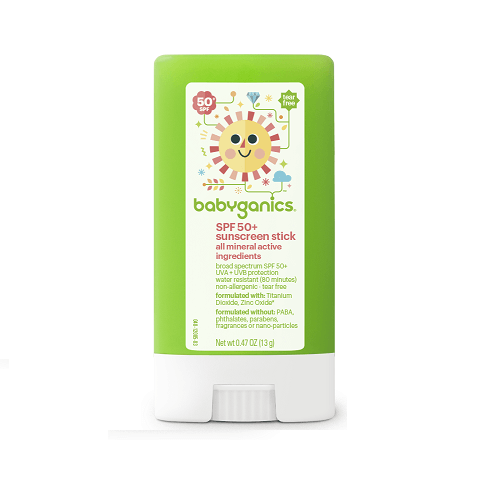
Active Ingredients are 7.9% TiO2 and 6.7% ZnO. Babyganics is better than other ZnO and TiO2 combinations, as it has the highest concentration of both and it simply uses good ingredients. As a bonus its fragrance free too. The major downside is that it’s a stick and therefore offers little value for money at US$14.87/oz.
2) Baby Bum Sunscreen Lotion SPF 50

Active ingredient is 20% ZnO, which provides broadspectrum coverage. SunBum make a mineral sunscreen of the same composition for adults and children. The kid’s version is fragrance free.
I like SunBum because it smells nice (coconut) and it uses decent emollients and moisturizers (such as shea butter).
3) Zinc Oxide 21.6% group
EACH of these SEVEN sunscreens have:
- One Active Ingredient: Zinc Oxide 21.6%
- Near identical Inactive ingredients, in the same/similar order that strongly suggests similar formulations.
Minor differences I’ve noted are: one is fragrance free (Neutrogena’s baby product) and the face products have Vitamin E (Tocopheryl Acetate) and Oatmeal (Colloidal Oatmeal).
I cannot stress this point enough:
ANY of these products will provide IDENTICAL protection against UVA and UVB rays.
Are there any price differences?
Yes. The cheapest products are the CVS Health ones.
Which would I use?
I would choose the CVS Zinc Face Sheer SPF 50 over Neutrogena’s SheerZinc Face Dry touch, as (i) it did not dry out my skin (ii) does not smell of industrial paint and (iii) its 50% cheaper.
i) The Neutrogena group
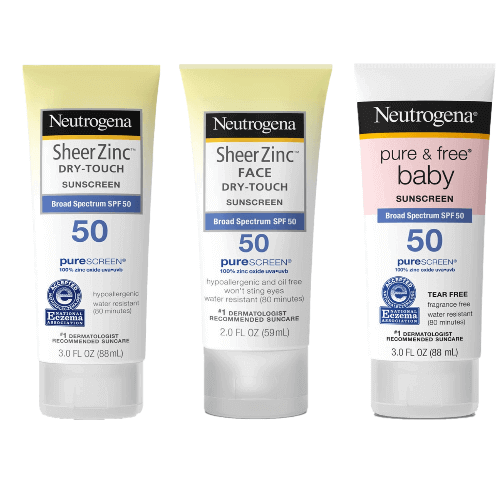
ii) The Aveeno group
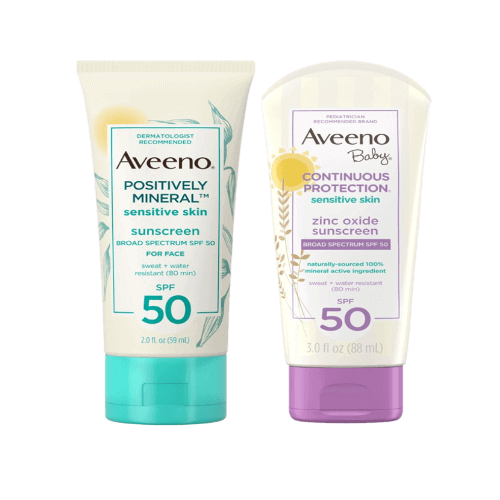
iii) The CVS Health group
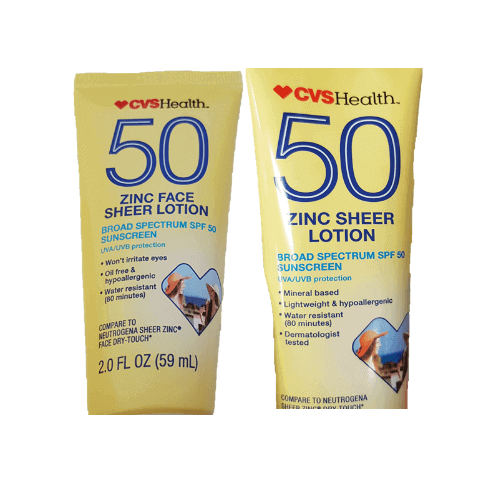
Closing remarks
It is atrocious that brands think that they can charge different prices for the same Zinc Oxide 21.6% product. However, you now have the information to buy the cheapest product with the same level of protection.
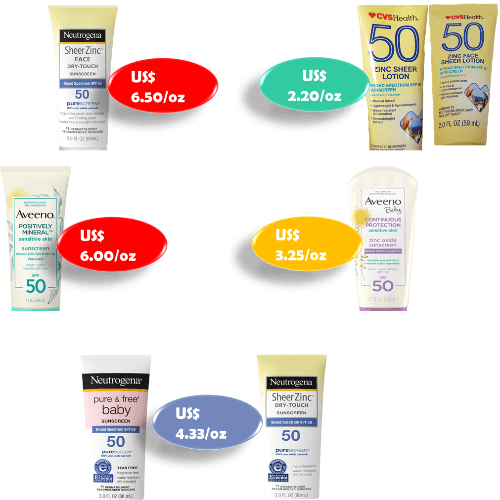
If this photo lacks visibility, then please refer to the following:
- US$ 2.10/oz – CVS Health Zinc Sheer Lotion SPF 50. CVS Health Zinc Sheer Face Lotion SPF 50 is likely to be similarly priced, but I can’t check as I don’t live in the USA
- US$ 3.25/oz – Aveeno Baby Sunscreen (Zinc Oxide) SPF 50
- US$ 4.33/oz – Neutrogena’s Pure & Free Baby Sunscreen SPF 50 and Neutrogena’s SheerZinc Dry Touch SPF 50
- US$ 6.00/oz – Aveeno Positively Mineral Sensitive Skin Sunscreen SPF 50
- US$ 6.50/oz – Neutrogena SheerZinc Face Dry Touch SPF 50
Notes:
Aveeno prices are Walgreens website, CVS prices are from a physical CVS pharmacy in NYC, Neutrogena prices are from the brand’s USA website. Data is accurate at date of publication
